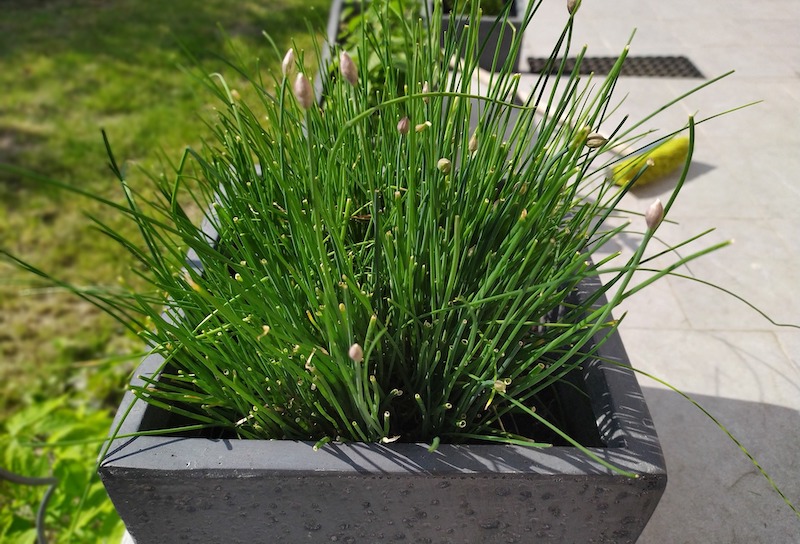Prized for both their mild onion flavor and edible, attractive flowers, chives are a welcome and low-maintenance addition to herb gardens. Chives, or Allium schoenoprasum, are perennial relatives of onion that offer a vigorous, clumping habit and excellent cold hardiness. These plants are among the easiest herbs to grow. These deer-resistant plants love moist soils but can tolerate drought and require little to no fertilizer applications.
Sometimes even used as ornamentals in rock gardens, the leaves form an attractive clump from which the lavender-colored flowers rise. Common, garlic, and curly chives are the most widely known varieties of chives.

Caring For Chives
This herb requires at least 6 to 8 hours of sunlight daily to thrive. A medium-fertility, loamy soil with plenty of organic matter will minimize the need for supplemental irrigation and fertilization. Keep the soil moist for best growth and tastiest harvest.
Regular plant rejuvenation every 2 to 3 years will keep plants growing vigorously. Time this process for mid-spring, well after new growth emerges. Simply dig up the plant and use a knife or spade to cleanly divide the root mass into even segments, and then replant these segments.
Planting Chives
Chives perform best in a site that receives full sunlight but can tolerate partial shade. They prefer a loamy soil with a pH between 5.8 and 7. The best time to sow seeds or transplant these cold-tolerant plants is spring. However, seeds or established transplants can also be sown or planted out in fall.
Working organic matter into the site to a depth of 1 foot prior to planting can often eliminate the need for supplemental fertilizer for chives completely. Whether starting with seeds, transplants, or divided clumps, space chive plants 4 to 6 inches apart. Large clumps and established plants should be spaced 12 to 20 inches apart, so it may be necessary to thin out the original planting eventually.
Watering Chives
Chives are tough, drought-tolerant plants, but where water is insufficient, they will experience a decrease in growth and productivity. To achieve the best chive plants, provide consistent moisture. They can do well in nearly saturated soils. As a general rule, aim for about an inch to an inch and a half of supplemental irrigation whenever rainfall is inadequate. Water the soil around the plant slowly and deeply.
Chives in sandy soil may require more frequent, lighter waterings than chives in soil with a high clay content. Working organic matter into the site prior to planting is an excellent way to improve soil structure and moisture retention.

Fertilizing Chives
A soil test prior to planting is the best way to determine if any amendments are recommended to boost soil fertility or structure or to bring the pH to within the 6 to 7 range that chives and many other herbs and vegetables prefer. These tough plants require little or no fertilizer. Working ample organic matter like well-rotted compost or manure into the site prior to planting often supplies chives with all of the nutrients they need to thrive.
Over time, continual harvesting can cause plants to lose some of their vigor and grow slowly. If this occurs, simply apply a slow-release, balanced fertilizer like a 5-10-5 formula at the lowest rate mentioned on the label around the plant clump each spring.
Growing Chives In Pots
Chives grow well in containers. In fact, this is one excellent way to keep clumps of the plant contained to a smaller area. It also allows a grower to bring the plant indoors for the winter for continual harvest year-round.
Chives grown in containers will be more prone to drying out than their counterparts cultivated in the ground, so plan to check on and water these plants regularly. Chive plants kept in pots also require supplemental fertilization that plants in the ground often do not need. For container plants, use a water-soluble, balanced fertilizer at about half the recommended label strength about once a month when the plant is actively growing.

Harvesting Chives
Chives are ready to harvest as soon as plants are established. From seed, it will take about 90 days to sustainably harvest the leaves; transplants or divided clumps will be ready within 2 months. Regular harvesting from established plants is key to encouraging further plant vigor. Snipping off and using or discarding flower stalks will push further vegetative growth.
Harvest chives by snipping leaves off at the base of the plant. Although the harvested chives have their best flavor when fresh, they are easily saved by washing the leaves, chopping them up, and then freezing them.
 |
Author Angela Ryczkowski - Published 3-17-2023 |
